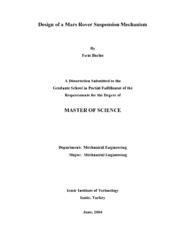Please use this identifier to cite or link to this item:
https://hdl.handle.net/11147/3449| Title: | Design of a Mars Rover Suspension Mechanism | Authors: | Barlas, Fırat | Advisors: | Alizade, Rasim | Publisher: | Izmir Institute of Technology | Abstract: | It is obvious that rovers are important vehicles of today.s solar system exploration. Most of the rover designs have been developed for Mars and Moon surface in order to understand the geological history of the soil and rocks. Exploration operations need high speed and long distance traversal in a short mission period due to environmental effects, climate and communication restrictions. Several mechanisms have been suggested in recent years for suspensions of rovers on rough terrain. Although their different mechanisms have found a widespread usage in mobile robotics, their low operation speed is still a challenging problem. In this research, a new suspension mechanism has been designed and its kinematic analysis results were discussed. Standard rocker-bogie suspension mechanism, which has been developed in the late 1990.s, has excellent weight distribution for different positions on rough terrain. New design, mostly similar to rocker-bogie suspension system, has a natural advantage with linear bogie motion which protects the whole system from getting rollover during high speed operations. This improvement increases the reliability of structure on field operations and also enables the higher speed exploration with same obstacle height capacity as rocker-bogie. In this thesis study, new bogie mechanism consisted of double-lambda mechanisms, which has been firstly presented by Pafnuty Lvovich Chebyshev in 1869, is solved by analytically to define the positions and singular configurations. A new structural synthesis formula also has been introduced for such suspension mechanisms with lower and higher kinematic pairs. By using structural synthesis methods, a suspension mechanism has been designed with double-lambda mechanism. Equivalent force and moment functions were also derived with equation of motion method. The results are confirmed with the computer analysis made by Visual Nastran 4D®. For this purpose, a computer model has been constructed and assembled with the same design parameters of NASA Mars Exploration Rovers (MER1 and MER2). | Description: | Thesis (Master)--Izmir Institute of Technology, Mechanical Engineering, Izmir, 2004 Includes bibliographical references (leaves: 71-75) xiii, 75 leaves |
URI: | http://hdl.handle.net/11147/3449 |
| Appears in Collections: | Master Degree / Yüksek Lisans Tezleri |
Files in This Item:
| File | Description | Size | Format | |
|---|---|---|---|---|
| T000341.pdf | MasterThesis | 1.82 MB | Adobe PDF |  View/Open |
CORE Recommender
Page view(s)
3,672
checked on Aug 4, 2025
Download(s)
4,570
checked on Aug 4, 2025
Google ScholarTM
Check
Items in GCRIS Repository are protected by copyright, with all rights reserved, unless otherwise indicated.